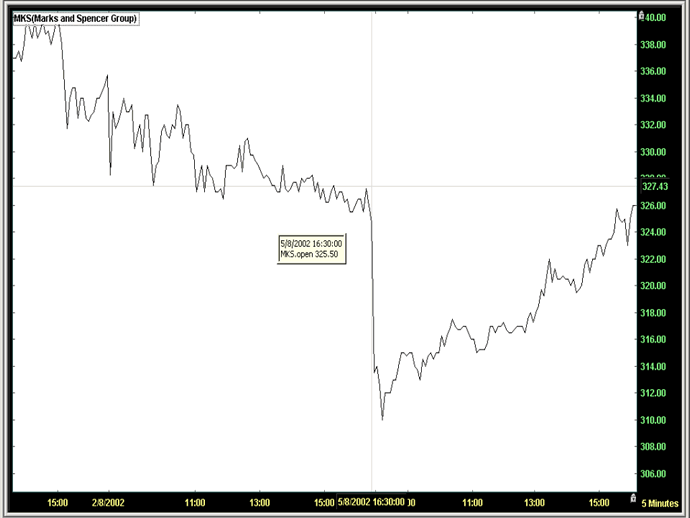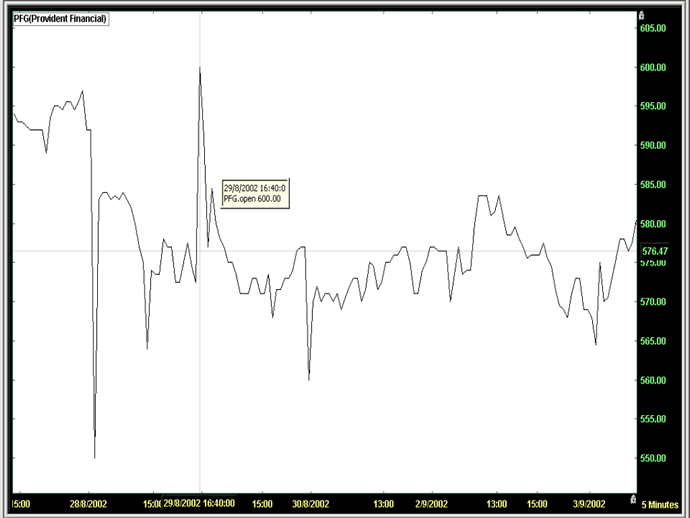Auctions Pre, Post and Intra-day
The advent of SETS on the London Stock Exchange in October 1997 and the introduction of the pre-, post- and intra-day auction processes in June has led to regular additional trading opportunities. Often the best prices for the day are achieved in the auctions. During the post-market auction, trading is suspended for five minutes from 16:30 to 16:35 and market participants can submit limit and ‘at-market’ orders. This can often create an imbalance if there is insufficient liquidity to fulfil the order, forcing prices up or down. The chart below illustrates clearly the trading opportunity when a seller of 6m shares of Marks and Spencer (MKS) temporarily led to the price dropping in the closing auction on August 5th. CFD traders took advantage, going long overnight and closing the trade the next day.

A similar situation can be seen to have taken place in Provident Financial (PFG), with the price rising up to 600p in the closing auction on August 29th on account of a big buyer and then another opportunity occurring the next day with the stock being sold down heavily to 560p and then reverting to its normal 575p range the next day.

It is important to remember that in the auction, all trades are conducted at the final ‘uncrossing’ price, so if your sell order was limited above the uncrossing price, you won’t trade, whereas if it is below the uncrossing price you will deal at the improved uncrossing price. The reverse holds true for buy orders. The uncrossing price is calculated in real time throughout the auction process by the Exchange based on the orders submitted at that time, in such a way as to execute the maximum number of orders possible.
IPOs and when-issued
Although the new issues market is particularly quiet at the moment, CFD traders can often trade a stock from the first day of conditional trading, i.e. when the stock is trading on a ‘when-issued’ basis. This puts him on a level footing with the institutions, whereas retail investors often have to wait until a week later when unconditional dealing commences. This allows trading and hedging opportunities for a number of days, when private clients are prevented from trading.
Lock ups
There have been a number of new issues this year, despite the state of the markets, including William Hill (WMH), Punch Taverns (PUB), Intertek (ITRK) and Wood Group (WG). Opportunities can often arise six or twelve months later when private equity and venture capitalists are released from their lock-up obligations, resulting in a flow of shares into the market, depressing the stock price. Traders anticipating this flow can take advantage by shorting the stock in advance and buying back later.
Stock Index Changes and Re-weightings
With over two hundred index-tracking funds, compared to just six in 1990, passive tracking funds are having an increasing influence on stocks prices. Following the ins and outs of stocks from indices has been a popular and profitable pastime in the last few years. The FTSE indices are reviewed quarterly, although ad-hoc changes are sometimes made, and the MSCI and STOXX indices are also regularly reviewed. Details can be found at www.ftse.com, www.msci.com and www.stoxx.com
Outright Shorts
CFDs provide an easy way to ‘short’ stocks either as a hedge against an underlying position but also to back a negative view on a stock that the trader believes may experience some short-term weakness or general fundamental over-valuation.
Pairs Trading
More sophisticated strategies can be pursued by placing a performance trade, buying one stock while simultaneously selling an equal consideration of another closely correlated one, usually in the same sector. This market neutral trade will then capture the difference in performance in the two stocks with a lower overall market risk. These strategies are particularly popular with hedge funds especially during times of high market volatility.
Stock Buybacks and Splits
Stock splits are generally viewed as bullish for a stock as although the value of a company is unaffected, the shares become more marketable. What generally happens in reality though is that the existing trend is amplified, so an over-performing stock will continue to do so, whereas the split may have little or no effect on an under-performing stock. Share consolidations (where say, a 10p stock is consolidated 10 for 1) can be counter-productive, and the stock will often quickly fall below its theoretical new price (in this example 100p). Companies and Directors are often restricted from dealing in their companies’ shares in the two months leading up to either interim or preliminary results. Bullish signs to look for are clusters of Directors buying or selling just before or after this period. Where Directors will have an early indication of trading conditions in the new financial year since the results apply to. Stocks can also experience weakness if a buy-back programme is suspended duringthis time.


Join the discussion